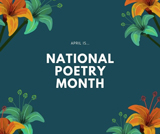 Autumn has finally arrived here in the Northwest corner, sneaking up on us perhaps because so much of October was dressed up in summer-like weather, but it’s still the perfect time to look back at some favorite reads from the summer just passed. Lining them all up, it seems that although I didn’t actually get to travel to Britain, I did spend a great deal of page-time there. Here, then, stacked on a nice Union Jack drape, a Brown Betty teapot for accent, is a Front Table featuring four great novels from three outstanding British authors.
Autumn has finally arrived here in the Northwest corner, sneaking up on us perhaps because so much of October was dressed up in summer-like weather, but it’s still the perfect time to look back at some favorite reads from the summer just passed. Lining them all up, it seems that although I didn’t actually get to travel to Britain, I did spend a great deal of page-time there. Here, then, stacked on a nice Union Jack drape, a Brown Betty teapot for accent, is a Front Table featuring four great novels from three outstanding British authors.
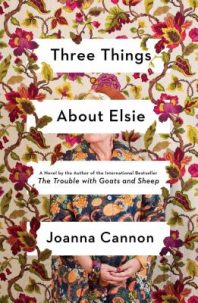 Author Joanna Cannon has only published two novels, but I’ve already added both to my Deserted Island list*. Both made the list by checking all the boxes: Did I laugh? Check. Did I need the occasional Kleenex? Check. Did I meet authentic characters I would happily spend years with, engaged in lively, if imaginary, conversation? Check and double check. Three Things About Elsie is Cannon’s brilliant second novel, a witty, moving and suspenseful tale of advancing age and fading memory. Having taken a fall, 84-year old Florence Claybourne waits for rescue on the floor of her apartment at the Cherry Tree Home for the Elderly. While she waits, she has plenty of time to look back over her life, from the one tragic night that happened decades earlier to the unlikely reappearance of someone from that past right there at Cherry Tree. Florence works to piece together fragments of her fugitive memory to explain how a man she thought long gone could turn up now, pretending to be someone else entirely. Through it all, she relies on the one constant through her whole long life– the sage advice and warm companionship of her best and oldest friend, Elsie. Three Things About Elsie blends menace and mystery with sly dialogue worthy of a classic Tracy and Hepburn movie, featuring an endearing cast of characters who transit the uncharted territory of old age with dignity and purpose. My favorite
Author Joanna Cannon has only published two novels, but I’ve already added both to my Deserted Island list*. Both made the list by checking all the boxes: Did I laugh? Check. Did I need the occasional Kleenex? Check. Did I meet authentic characters I would happily spend years with, engaged in lively, if imaginary, conversation? Check and double check. Three Things About Elsie is Cannon’s brilliant second novel, a witty, moving and suspenseful tale of advancing age and fading memory. Having taken a fall, 84-year old Florence Claybourne waits for rescue on the floor of her apartment at the Cherry Tree Home for the Elderly. While she waits, she has plenty of time to look back over her life, from the one tragic night that happened decades earlier to the unlikely reappearance of someone from that past right there at Cherry Tree. Florence works to piece together fragments of her fugitive memory to explain how a man she thought long gone could turn up now, pretending to be someone else entirely. Through it all, she relies on the one constant through her whole long life– the sage advice and warm companionship of her best and oldest friend, Elsie. Three Things About Elsie blends menace and mystery with sly dialogue worthy of a classic Tracy and Hepburn movie, featuring an endearing cast of characters who transit the uncharted territory of old age with dignity and purpose. My favorite 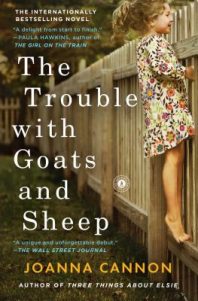 novel this year!
novel this year!
Cannon’s first novel, The Trouble with Goats and Sheep, also features memorable main characters, but on the opposite end of the age spectrum from Florence and crew. Ten-year old best friends Grace and Tilly– part Harriet the Spy and part Scout Finch– turn detective when one of their neighbors on Mulberry Avenue goes missing. The adults around them seem willing to chalk up Mrs. Creasy’s sudden disappearance to the effects of the summer’s heat wave, but the girls think something much more sinister may be afoot. As their investigation takes them door-to-door around the cul-de-sac, they begin to understand that their quiet neighborhood harbors many secrets, all seeming to lead back to something that happened at the top of the road many years before. This is a great story about friendship and family, prejudice and loyalty, all seen through the guileless naiveté of ten-year old eyes.
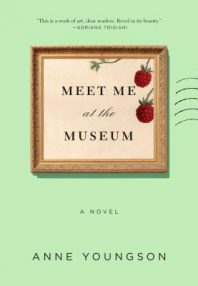 There’s a certain illicit pleasure to be found in reading an epistolary novel, the granting of permission to read someone else’s mail without feeling guilty. Anne Youngson’s debut, Meet Me at the Museum, uses this novel-in-letters format perfectly, gradually letting us see into the private lives and thoughts of her two characters. Tina Hapgood, middle-aged British farm wife, pens a letter to a Danish professor. They’ve never met, but fifty years before they shared a tenuous connection through the professor’s book about the famous Iron Age bog man called the Tolland Man. In her letter, Tina confides her regret that she never fulfilled a promise to her best friend that they would someday travel to Denmark to visit the mummy. To her surprise, she receives a response, but not from her professor, now, it appears, long dead. Instead her correspondent is Anders Larsen, current curator of the Silkeborg Museum. His first letter is somewhat impersonal, a response simply to her questions about the lives of the Iron Age humans on display at his museum. But as time goes on, and the letters keep going back and forth, a friendship develops, as both Tina and Anders slowly reveal themselves by committing to paper things they cannot, would not share with anyone else. Eventually these two people who have never met and who live a sea apart come to know each other intimately. Telling this story in letters, real letters, rather than texts or Facebook posts or even cell phone calls, makes the development of this relationship feel so immediate, so tangible, so organic that Tina and Anders, with all their cares and hopes, come right off the page. I read this book in one giant gulp, so invested in these two lives that I literally could not put it down until I was sure they would be all right. You’ll be cheering for them, too, right up to the very last page.
There’s a certain illicit pleasure to be found in reading an epistolary novel, the granting of permission to read someone else’s mail without feeling guilty. Anne Youngson’s debut, Meet Me at the Museum, uses this novel-in-letters format perfectly, gradually letting us see into the private lives and thoughts of her two characters. Tina Hapgood, middle-aged British farm wife, pens a letter to a Danish professor. They’ve never met, but fifty years before they shared a tenuous connection through the professor’s book about the famous Iron Age bog man called the Tolland Man. In her letter, Tina confides her regret that she never fulfilled a promise to her best friend that they would someday travel to Denmark to visit the mummy. To her surprise, she receives a response, but not from her professor, now, it appears, long dead. Instead her correspondent is Anders Larsen, current curator of the Silkeborg Museum. His first letter is somewhat impersonal, a response simply to her questions about the lives of the Iron Age humans on display at his museum. But as time goes on, and the letters keep going back and forth, a friendship develops, as both Tina and Anders slowly reveal themselves by committing to paper things they cannot, would not share with anyone else. Eventually these two people who have never met and who live a sea apart come to know each other intimately. Telling this story in letters, real letters, rather than texts or Facebook posts or even cell phone calls, makes the development of this relationship feel so immediate, so tangible, so organic that Tina and Anders, with all their cares and hopes, come right off the page. I read this book in one giant gulp, so invested in these two lives that I literally could not put it down until I was sure they would be all right. You’ll be cheering for them, too, right up to the very last page.
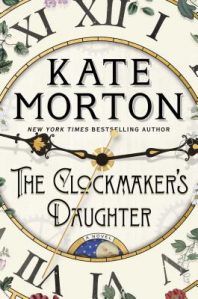 I’ve long been a fan of author Kate Morton’s brand of gothic-y suspense, and eagerly looked forward to reading The Clockmaker’s Daughter. I was not disappointed. Morton’s great talent is in slowly pulling back the layers of secrecy covering sins long past, revealing crimes of passion, betrayal and violence that continue to echo down generations. Elodie Winslow works in the quiet London offices of a professional archivist firm, more comfortable with the artifacts of her research than with the mess and hurry of contemporary life. To pass a slow afternoon, she investigates a mundanely labeled box–“Contents of attic desk drawer”– unopened and misfiled in a storage room for nearly fifty years. Inside, along with the usual desk paraphernalia, Elodie finds a leather satchel, and inside that, an artist’s sketchbook and the sepia-toned photograph of a beautiful young woman dressed in Victorian-era clothes. Riffling through the sketchbook, she is arrested by a drawing of a house– the very image of the house her mother described to her night after night in her favorite childhood bedtime story. Her professional curiosity as an archivist melds with her personal affinity with the era, and she sets out to find the house and identify the woman in the photo. Eventually she is led to the story of a group of artists who, in the summer of 1862, retreated to a manor on the Thames– the same house pictured in the sketchbook– seeking freedom from convention and the inspiration to create. But there’s someone else in this novel, another voice telling us this same story from the inside out. Someone whose name is lost to history, but who was both witness and catalyst in that idyllic summer that went so horribly wrong: the clockmaker’s daughter, still waiting after a century and a half for the truth to be found out, and for the peace that will follow.
I’ve long been a fan of author Kate Morton’s brand of gothic-y suspense, and eagerly looked forward to reading The Clockmaker’s Daughter. I was not disappointed. Morton’s great talent is in slowly pulling back the layers of secrecy covering sins long past, revealing crimes of passion, betrayal and violence that continue to echo down generations. Elodie Winslow works in the quiet London offices of a professional archivist firm, more comfortable with the artifacts of her research than with the mess and hurry of contemporary life. To pass a slow afternoon, she investigates a mundanely labeled box–“Contents of attic desk drawer”– unopened and misfiled in a storage room for nearly fifty years. Inside, along with the usual desk paraphernalia, Elodie finds a leather satchel, and inside that, an artist’s sketchbook and the sepia-toned photograph of a beautiful young woman dressed in Victorian-era clothes. Riffling through the sketchbook, she is arrested by a drawing of a house– the very image of the house her mother described to her night after night in her favorite childhood bedtime story. Her professional curiosity as an archivist melds with her personal affinity with the era, and she sets out to find the house and identify the woman in the photo. Eventually she is led to the story of a group of artists who, in the summer of 1862, retreated to a manor on the Thames– the same house pictured in the sketchbook– seeking freedom from convention and the inspiration to create. But there’s someone else in this novel, another voice telling us this same story from the inside out. Someone whose name is lost to history, but who was both witness and catalyst in that idyllic summer that went so horribly wrong: the clockmaker’s daughter, still waiting after a century and a half for the truth to be found out, and for the peace that will follow.
* Full disclosure: I would need to be washed ashore atop a book-packed shipping container to accommodate my entire Deserted Island list. Ideally with a teakettle and bales of darjeeling.
Kristine Kaufman is a retired bookseller and forever bibliophile. She was a co-owner of Snow Goose Books and Frames, which was in Stanwood, WA. She still calls the Pacific Northwest home.


